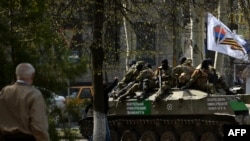The topic of the week is a half-hour-long Saturday program of RFE/RL’s Balkan Service. In April 2014 Mirjana Rakela edited the program that was wholly dedicated to the similarities and differences between the Yugoslav crisis of the 1990s and the current crisis in the Ukraine.
The comparison is not always useful, yet some parallels are striking, according to Rakela’s program. Milosevic claimed to be defending the right of all Serbs to live in the same state, just as Putin has justified his intervention in Crimea citing concern for Russian speakers in Ukraine. History never repeats itself exactly, but it seems clear that the protagonists of the “Greater Serbia” project had been schooled in Moscow.
No one in Bosnia is indifferent to the news emanating from Ukraine on a daily basis. Many citizens of Bosnia’s capital, Sarajevo, have been reminded of start of the war in their own city 20 years ago, which also began with street barricades, masked gunmen in unmarked uniforms, snipers on rooftops, and accusations that Bosnians were shooting at fellow Bosnians. The war in Bosnia was also preceded by a crisis of the political system, and rival politicians’ inability to come to an agreement, as well as the impotence of the international community, unable or unwilling to prevent the war. Marija Arnautovic spoke to former diplomats, journalists, and public figures in Sarajevo to get their perspective on the Ukrainian crisis: Echoes of the Bosnian War in Ukraine.
The methods of mobilizing public support for the protection one’s own ethnic group are virtually identical in Russia today as they were in Serbia twenty years ago. Milosevic’s propaganda machine may not have been as effective as Putin’s, but the Serbian leader was nevertheless extremely adept at waging war with one hand while toasting the latest peace proposal with the other. Iva Martinovic’s report takes us back to the “The Happening of the People” in early 1990s Belgrade: Events in Ukraine a Chilly Reminder of Milosevic's Tactics.
(*The "Happenings of the People" was a series of "people's rallies" in late 1980s staged by Milosevic which led to "anti-bureaucratic revolutions" in Vojvodina and Montenegro that helped him put them under his control.)
According to leading Montenegrin historians, as Srdjan Jankovic reports, there are also similarities between the profound ethnic divisions in Ukraine and the Balkans – which in the early 1990s led to the formation of ethnic political parties, military and paramilitary forces, and self-proclaimed autonomous regions and republics in the Balkans. There are also parallels in the reaction of the international community to the Ukrainian crisis, reminiscent of the indecision and weakness that characterized outside attempts to resolve the Balkan conflicts. Meanwhile, the inability of those on either side of the conflict to resolve their disputes through political dialogue is another common feature of the Ukrainian and Balkan crises, examined in the story: Dissolution of Yugoslavia as a Warning to those in Charge of European Security.
Topic of the Week: Yugoslavia and Ukraine - similarities and differences




